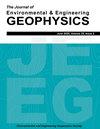平原水库下咸水含水层淡水入侵的地球物理评价
IF 0.7
4区 工程技术
Q4 ENGINEERING, GEOLOGICAL
引用次数: 1
摘要
水库渗漏会造成宝贵水资源的浪费,甚至造成严重的环境后果。本文采用连续电阻率剖面法对南水北调东线双王城水库的渗漏问题进行了评价。通过数值算例验证了该方法在含盐含水层环境中的有效性。水运测量线35条,总长74 km,地面测量线2条,总长1.27 km。我们用交点的视电阻率来评价整体资料的质量。根据地面调查结果,电阻率值大于2 Ω。将储层底部的M视为泄漏区。因此,我们将电阻率测量结果划分为淡水储层、渗漏层和咸水含水层三个区域。利用栅栏图和插值的水平电阻率等值线图评价了淡水侵入的分布。圈定的渗漏带与储层北部和东部缺乏低渗透壤土层相一致。结果表明,水基电阻率测量方法能有效、高效地评价储层内部的渗漏分布。本文章由计算机程序翻译,如有差异,请以英文原文为准。
Geophysical Assessment of Freshwater Intrusion into Saline Aquifers Beneath Plain Reservoirs
Reservoir leakage can cause a waste of precious water resources and even severe environmental consequences. In this study, we use continuous resistivity profiling to evaluate the leakage problem of the Shuangwangcheng reservoir along the east route of the South-to-North Water Diversion Project. A numerical example was first built to validate the method's effectiveness in a saline aquifer environment. Thirty-five waterborne survey lines were then conducted with a total length of 74 km, and two ground survey lines had a length of 1.27 km each. We evaluated the quality of the overall data with the apparent resistivity of intersection points. Based on ground survey results, the resistivity value larger than 2 Ω.m at the bottom of the reservoir is regarded as leakage areas. Therefore, we divide resistivity survey results into three zones: freshwater reservoir, leakage zone, and saline aquifer. The distribution of freshwater intrusion is evaluated by fence diagram and interpolated horizontal resistivity contour maps. The delineated leakage zone is consistent with the lack of a low permeable loam layer on the north and east parts of the reservoir. The results prove that the waterborne resistivity survey method can efficiently and effectively assess leakage distribution inside a reservoir.
求助全文
通过发布文献求助,成功后即可免费获取论文全文。
去求助
来源期刊

Journal of Environmental and Engineering Geophysics
地学-地球化学与地球物理
CiteScore
2.70
自引率
0.00%
发文量
13
审稿时长
6 months
期刊介绍:
The JEEG (ISSN 1083-1363) is the peer-reviewed journal of the Environmental and Engineering Geophysical Society (EEGS). JEEG welcomes manuscripts on new developments in near-surface geophysics applied to environmental, engineering, and mining issues, as well as novel near-surface geophysics case histories and descriptions of new hardware aimed at the near-surface geophysics community.
 求助内容:
求助内容: 应助结果提醒方式:
应助结果提醒方式:


